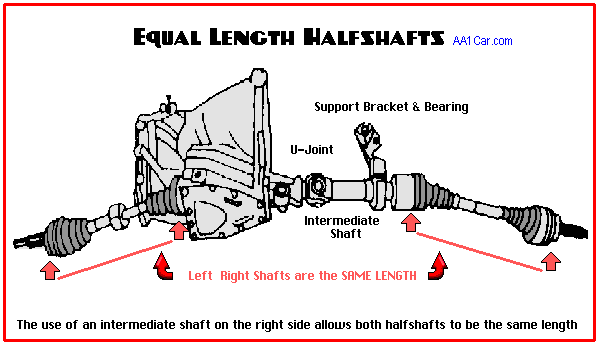Torque steer․ It’s a term that sends shivers down the spines of front-wheel-drive enthusiasts, conjuring images of unruly steering wheels and unpredictable acceleration․ But what about all-wheel-drive (AWD) vehicles? Do they experience this phenomenon? The answer, as with many things automotive, isn’t a simple yes or no․ Let’s dive into the mechanics of torque steer, explore how it manifests in different drive systems, and ultimately, determine if AWD cars are truly immune․ Prepare to have your understanding of vehicle dynamics challenged!
Understanding Torque Steer in AWD Systems
Torque steer, at its core, is a steering disturbance caused by unequal forces applied to the front wheels during acceleration․ This typically occurs in front-wheel-drive cars because the engine’s power is directly routed to the front axle․ But what happens when that power is distributed to all four wheels?
How Torque Distribution Affects AWD Torque Steer
The key lies in the AWD system’s torque distribution strategy․ Some AWD systems primarily drive the front wheels, sending power to the rear only when needed (e․g․, when the front wheels slip)․ In these cases, a degree of torque steer can be present, although significantly less pronounced than in a dedicated front-wheel-drive car․ Other AWD systems have a more balanced or rear-biased torque split, which minimizes the potential for torque steer․
Interesting Tip: The sophistication of the AWD system plays a crucial role․ Modern electronic systems can actively manage torque distribution, mitigating torque steer by precisely controlling the power sent to each wheel․
Factors Contributing to AWD Torque Steer
Even in AWD vehicles, several factors can contribute to the sensation of torque steer, although it’s often more subtle:
- Unequal Axle Lengths: Similar to FWD cars, unequal axle lengths can create different angles and leverage, leading to slight steering pull․
- Differential Behavior: The type of differential used (open, limited-slip, or electronic) affects how torque is distributed between the wheels․
- Suspension Geometry: Suspension design and alignment can influence how the car reacts to torque application․
AWD Systems and the Mitigation of Torque Steer
AWD systems are inherently better equipped to handle torque steer than FWD systems․ Distributing power to all four wheels reduces the load on the front axle, minimizing the unequal forces that cause the steering disturbance․ However, it’s not a complete elimination․
The Role of Electronic Stability Control (ESC) in AWD Torque Steer
Modern vehicles equipped with AWD often include Electronic Stability Control (ESC) systems․ ESC uses sensors to detect wheel slip and can apply brakes to individual wheels to counteract torque steer and maintain stability․ This further reduces the likelihood of experiencing noticeable torque steer․
Information Callout: Many high-performance AWD cars utilize advanced torque vectoring systems․ These systems actively distribute torque between the rear wheels, enhancing handling and further minimizing any remaining torque steer tendencies․
Examples of AWD Cars and Their Torque Steer Characteristics
Consider these examples:
- Subaru WRX/STI: These cars, known for their symmetrical AWD systems, generally exhibit very little torque steer due to their balanced torque distribution․
- Audi Quattro (Older Models): Some older Quattro systems, particularly those with a front-biased torque split, could exhibit a slight degree of torque steer under hard acceleration․
- Modern Performance SUVs with AWD: Many performance SUVs now feature sophisticated AWD systems with torque vectoring, effectively eliminating torque steer even with high horsepower outputs․
Diagnosing and Addressing Potential AWD Torque Steer Issues
While true torque steer is rare in modern AWD cars, a pulling sensation during acceleration can sometimes indicate other problems․ It’s important to differentiate between genuine torque steer and other potential issues․
Troubleshooting Steering Pull in AWD Vehicles
If you experience a pulling sensation in your AWD car, consider the following:
- Tire Condition: Uneven tire wear or mismatched tires can cause pulling․
- Wheel Alignment: A misaligned suspension can lead to steering issues․
- Brake Problems: A dragging brake caliper can create a pulling sensation․
- Suspension Components: Worn or damaged suspension parts can affect steering․
When to Seek Professional Help for AWD Torque Steer Concerns
If you’ve ruled out the above issues and still suspect a problem with your AWD system, it’s best to consult a qualified mechanic․ They can diagnose any underlying mechanical or electronic issues that might be contributing to the pulling sensation․
Frequently Asked Questions About AWD and Torque Steer
So, do AWD cars have torque steer? The answer is nuanced․ While not entirely immune, modern AWD systems, especially those with advanced electronic controls, effectively minimize or eliminate the sensation of torque steer․ The next time you’re behind the wheel of an AWD vehicle, pay attention to how it handles during acceleration․ You might be surprised at how well it manages the power, delivering a smooth and controlled driving experience․ Remember that proper maintenance and addressing any underlying mechanical issues are crucial for optimal performance․ Happy driving!






